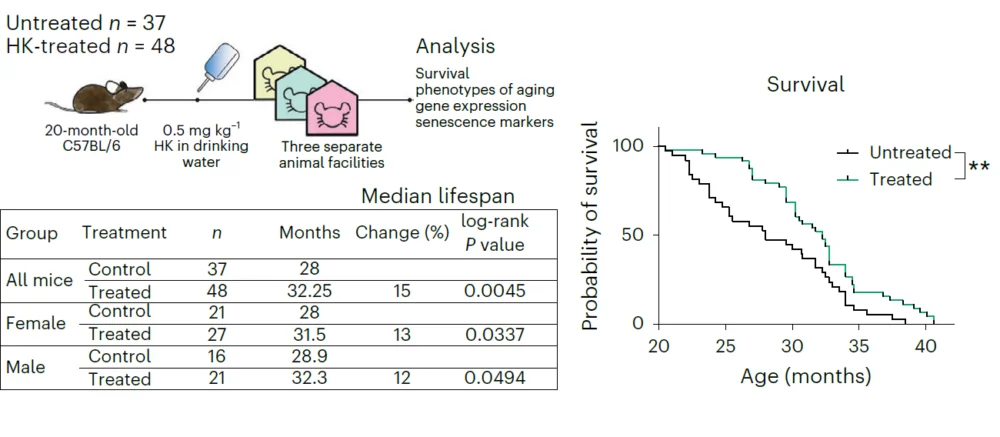A Botanical Extract Extends Lifespan and Healthspan in Mice
- The extract had a potent effect even when used in low doses.

According to a new study, a polyphenol-rich natural extract positively impacts lifespan, healthspan, and cellular senescence. These results were observed in both cell culture and a mouse model [1].
From folk medicine to modern science
Traditional and folk medicines offer many botanical extracts that can be tested by modern science for their medicinal properties and influences on aging. One such plant is the Bolivian prawn sage (Salvia haenkei).
Salvia haenkei is a fast growing perennial plant with aromatic leaves and upright stems of red, prawn-like flowers. It is native to Bolivia and southern Peru and is found in the seasonally dry tropical environment of those countries.
This study’s authors had previously screened botanical extracts and discovered that an extract from Salvia haenkei delays cellular senescence in human cell cultures [2]. The extract is called Haenkenium (HK).
Longer and healthier lives
In this study, the authors administered HK to the drinking water of 20-month-old mice until the ends of their lives. The mice that consumed HK lived longer than the control group: a median lifespan of 32.25 months compared to 28 months.
This lifespan effect was sex-independent, as both male and female mice treated with HK had longer lifespans. The researchers also reported no observed signs of toxicity.

Improvements in lifespan were accompanied by improvements in healthspan, as HK-treated animals’ age-related phenotypes were improved compared to the control group.
Those phenotypes included abnormal rounding of the upper back (kyphosis), tumor development, fur quality, bone structure, grip strength, and kidney function. In other words, not only did the mice live longer, they were also healthier.
Impacts on gene expression
The authors compared muscle-specific gene expression between young and old animals. They also analyzed the impact of HK treatment on age-related gene expression changes.
The analysis identified genes that are upregulated and downregulated during aging. In mice treated with HK, they observed comparative downregulation of aging-upregulated genes and upregulation of aging-downregulated genes.
The researchers also noted the molecular pathways and processes of these age-related gene expression changes, which included inflammation, immune activation, cellular senescence, and the senescence-associated secretory phenotype (SASP).
In mice treated with HK, these pathways were relatively suppressed. To be certain, the researchers used multiple methods to confirm these findings in different tissues.
Beyond aging
Cellular senescence can result from natural aging or can be induced by stressors, such as chemotherapy [3]. Since HK was effective in ameliorating the effects of senescence caused by aging, the researchers hypothesized that it could be effective in ameliorating the effects of chemotherapy on senescence.
They treated the mice with doxorubicin, a potent chemotherapeutic agent that induces cellular senescence [4]. The mice treated with doxorubicin that also consumed water with HK had fewer accumulated senescent cells and didn’t lose as much body weight as the controls.
Doxorubicin is also known for causing cardiac dysfunction by inducing senescence in cardiac tissue [5]. In this study, the researchers induced senescence with doxorubicin in human-induced cardiomyocyte cells and then treated them with HK. HK treatment significantly reduced senescence in those cells. However, as researchers caution, there is still a need to test the impact of HK on chronic exposure to doxorubicin to better reflect clinical settings.
Finding the active component
Since the HK extract has shown such promising results, the researchers were curious about which component of this botanical extract is responsible for those effects. They identified several groups of molecules in the extract, including phenols/lignans, flavonoids, and terpenes. Previous research reported that flavonoids can modulate cellular senescence [6, 7]; the researchers decided to focus mainly on this group for further exploration.
Testing several flavonoids present in HK revealed that three had an impact on senescence that were similar to overall HK treatment. Among those three, luteolin and its derivatives account for 1.33% of the HK extract, making it the most prevalent flavonoid.
Subsequent experiments, in cell culture and mice, have shown that luteolin acted similarly to HK in preventing the accumulation of senescent cells after senescence induction by UV or doxorubicin, which suggests that luteolin is a key component of HK.
On the molecular level, the researchers identified that luteolin binds to the cell cycle regulator CDK6 and disrupts binding between the cell cycle inhibitor p16 and CDK6. The increase in p16 plays a part in developing senescence by blocking CDK6 activity and inhibiting the cell cycle [8]. The researchers suggest that this is luteolin’s mechanism of action in preventing or delaying the onset of senescence.
Strengths and weaknesses
Luteolin, identified in this study as an active compound with anti-senescence properties, is not only found in HK but in many edible vegetables and herbs and has been described previously to have antioxidant, anti-inflammatory, and anticancer properties [9, 10], which makes it an interesting candidate for further studies and clinical trials.
The researchers point out that contrary to many studies of different compounds, the dose they used is low, which makes it a promising candidate for use as a supplement or in pharmaceuticals. Additionally, those researchers have demonstrated that even treatment started relatively later in life can still show many beneficial effects, which makes it promising for humans. However, the researchers focused on a limited number of age-associated phenotypes, and further research is needed to assess if HK also impacts different aspects of aging.
This paper focused on luteolin and its anti-senescence properties, but other components of HK may also significantly contribute to lifespan and healthspan extension, which requires further investigation.
Lastly, the authors caution that their study involved experiments done on inbred mice, and further research should confirm if these effects are also observed in a more genetically heterogeneous population.
Literature
[1] Zumerle, S., Sarill, M., Saponaro, M., Colucci, M., Contu, L., Lazzarini, E., Sartori, R., Pezzini, C., Rinaldi, A., Scanu, A., Sgrignani, J., Locatelli, P., Sabbadin, M., Valdata, A., Brina, D., Giacomini, I., Rizzo, B., Pierantoni, A., Sharifi, S., . . . Alimonti, A. (2024). Targeting senescence induced by age or chemotherapy with a polyphenol-rich natural extract improves longevity and healthspan in mice. Nature Aging.
[2] Matic, I., Revandkar, A., Chen, J., Bisio, A., Dall’Acqua, S., Cocetta, V., Brun, P., Mancino, G., Milanese, M., Mattei, M., Montopoli, M., & Alimonti, A. (2016). Identification of Salvia haenkei as gerosuppressant agent by using an integrated senescence-screening assay. Aging, 8(12), 3223–3240.
[3] Demaria, M., O’Leary, M. N., Chang, J., Shao, L., Liu, S., Alimirah, F., Koenig, K., Le, C., Mitin, N., Deal, A. M., Alston, S., Academia, E. C., Kilmarx, S., Valdovinos, A., Wang, B., de Bruin, A., Kennedy, B. K., Melov, S., Zhou, D., Sharpless, N. E., … Campisi, J. (2017). Cellular Senescence Promotes Adverse Effects of Chemotherapy and Cancer Relapse. Cancer discovery, 7(2), 165–176.
[4] Ludke, A., Akolkar, G., Ayyappan, P., Sharma, A. K., & Singal, P. K. (2017). Time course of changes in oxidative stress and stress-induced proteins in cardiomyocytes exposed to doxorubicin and prevention by vitamin C. PloS one, 12(7), e0179452.
[5] Lazzarini, E., Lodrini, A. M., Arici, M., Bolis, S., Vagni, S., Panella, S., Rendon-Angel, A., Saibene, M., Metallo, A., Torre, T., Vassalli, G., Ameri, P., Altomare, C., Rocchetti, M., & Barile, L. (2022). Stress-induced premature senescence is associated with a prolonged QT interval and recapitulates features of cardiac aging. Theranostics, 12(11), 5237–5257.
[6] Fan, X., Fan, Z., Yang, Z., Huang, T., Tong, Y., Yang, D., Mao, X., & Yang, M. (2022). Flavonoids-Natural Gifts to Promote Health and Longevity. International journal of molecular sciences, 23(4), 2176.
[7] Lim, H., Park, H., & Kim, H. P. (2015). Effects of flavonoids on senescence-associated secretory phenotype formation from bleomycin-induced senescence in BJ fibroblasts. Biochemical pharmacology, 96(4), 337–348.
[8] Campisi, J., & d’Adda di Fagagna, F. (2007). Cellular senescence: when bad things happen to good cells. Nature reviews. Molecular cell biology, 8(9), 729–740.
[9] Gendrisch, F., Esser, P. R., Schempp, C. M., & Wölfle, U. (2021). Luteolin as a modulator of skin aging and inflammation. BioFactors (Oxford, England), 47(2), 170–180.
[10] Seelinger, G., Merfort, I., Wölfle, U., & Schempp, C. M. (2008). Anti-carcinogenic effects of the flavonoid luteolin. Molecules (Basel, Switzerland), 13(10), 2628–2651.








